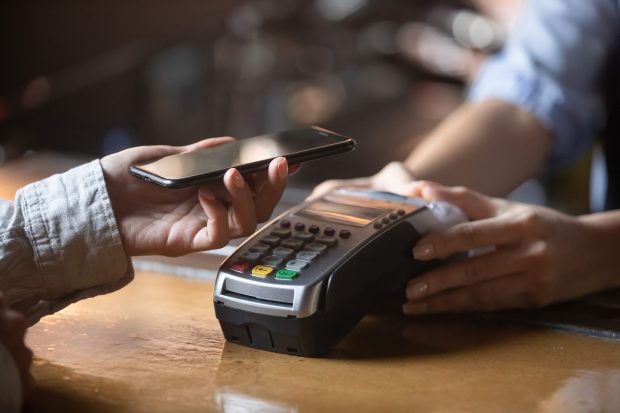Deep Dive: Why Debit Is Driving the A2A Payments Expansion

Contactless payments have risen in popularity during the pandemic as consumers have sought easier and safer ways to pay for the things they need. At the same time, debit is becoming the payment vehicle of choice for debt-wary consumers who prefer to spend from their checking accounts rather than run up tabs on their credit cards.
Approximately one in six consumers made their first contactless purchases last year, and nearly nine in 10 of those first-time users plan to continue using contactless payments, according to a survey. In addition, some nine in 10 people with bank accounts were using debit cards, primarily due to a decrease in cash use to reduce the risk of virus transmission. Consumers ages 18 to 24 made up the largest group of debit users at 96%, while those ages 65 and up represented the lowest share of debit users at 68%.
In August, debit purchases were up 33% from August 2019, whereas credit purchases were up just 23%. Does this rise in popularity mean that debit cards will be the death of credit cards, and how does debit converge with the growth in contactless payments? The following Deep Dive examines trends in contactless and card-not-present (CNP) debit use. It also explores where trends in this space are likely to head in the near future.
The Rise in Digital Debit Use
The pandemic led to a shift not only in digital payments but also in debit as consumers became more concerned about their finances. The health crisis also contributed to debit’s popularity through the distribution of stimulus checks via prepaid cards, debit cards and direct deposits into consumers’ checking accounts. One study reported that digital debit card transaction value in the U.S. grew 73% in 2020. Meanwhile, digital credit card transaction value rose just 38% — marking the first time since 2014 that credit’s share of digital transaction values fell below 50%.
There is little doubt that debit is gaining popularity, especially among younger and more debt-averse populations who want more control and visibility into their finances. This same group has the technological know-how to leverage apps such as mobile wallets to use debit more easily and safely both online and at the point of sale (POS).
Contactless, CNP and PINless Debit Trends
Merchants looking to attract and keep customers have been working to make it easier for shoppers to use their debit cards while keeping physical contact to a minimum. Mobile wallets, such as Apple Pay and Google Pay, as well as account-to-account (A2A) platforms, such as Square, Venmo and Zelle, that allow a direct connection to checking accounts continue to proliferate. A new report forecasts that transaction volumes for mobile payments will grow from 26 billion in 2021 to 49 billion in 2023, representing growth of approximately 92%.
Merchants have been wise to pay close attention to debit’s rise in everyday transactions. Another survey found that non-acceptance of debit cards impacts the amount that shoppers spend and that 70% of consumers would not return to a merchant that does not accept debit.
While consumers may prefer to reduce contact when using their debit cards, they do not necessarily feel secure about the technology. The report suggested that digital wallet services take advantage of opportunities to offer loyalty programs and personal financial management to encourage customers to switch to contactless mobile wallets.
CNP transactions, which occur when a payment is accepted without capturing electronic data from a card that has been swiped, scanned or tapped at a retailer POS, are also on the rise. U.S retailers reported a considerable increase in CNP transactions during the back-to-school shopping season. A September report found that in the sports apparel category, CNP credit card purchases increased 5 percentage points year over year, while CNP transactions represented 33% of debit card purchases — up 121 percentage points from August 2020.
Another type of contactless debit includes single-message transactions processed through debit networks without the need for PINs, or PINless transactions. A PIN is typically used in-store but, as transactions shift online, PIN authentication becomes more difficult. PINless transactions allow merchants to route contactless or online transactions to domestic debit networks to drive more savings. One of the factors holding back the expanded use of PINless debit is that some local debit networks still have not adopted the technology necessary to process such transactions — even if merchants have. One report found that many card issuers do not enable PINless functionality when issuing bank debit cards, resulting in merchants not being able to process PINless sales up to 50% of the time.
The limitations on PINless use also seem to be a matter of what brings in revenue for the banks issuing debit cards. The 2010 Durbin Amendment capped the interchange or swipe fees that merchants are charged for processing debit transactions to 22 cents — a move that discouraged some network providers from honoring PINless transactions because of the potential cost.
In general, merchants still cannot choose which payment networks can process online debit card transactions, leaving them at the mercy of banks that may or may not honor online PINless debit. If more merchants were able to process PINless debit transactions at lower cost and on competing networks, one report argued, U.S. merchants could drive up to $3.1 billion in savings as consumers shift to doing more business online.
Contactless, PINless and CNP debit have been gaining in use, but analysts remain guarded as to whether these trends will hold. They predict that digital debit’s growth will shrink in 2021 and slowly rise again in the next two years to reach a value of $443.49 billion in 2023.
Still, it appears that these contactless payment methods are popular among consumers. While merchants seem poised and encouraged to offer the services as a convenience to customers hesitant to shop in person, it remains to be seen if networks and issuing banks will meet their demands.
